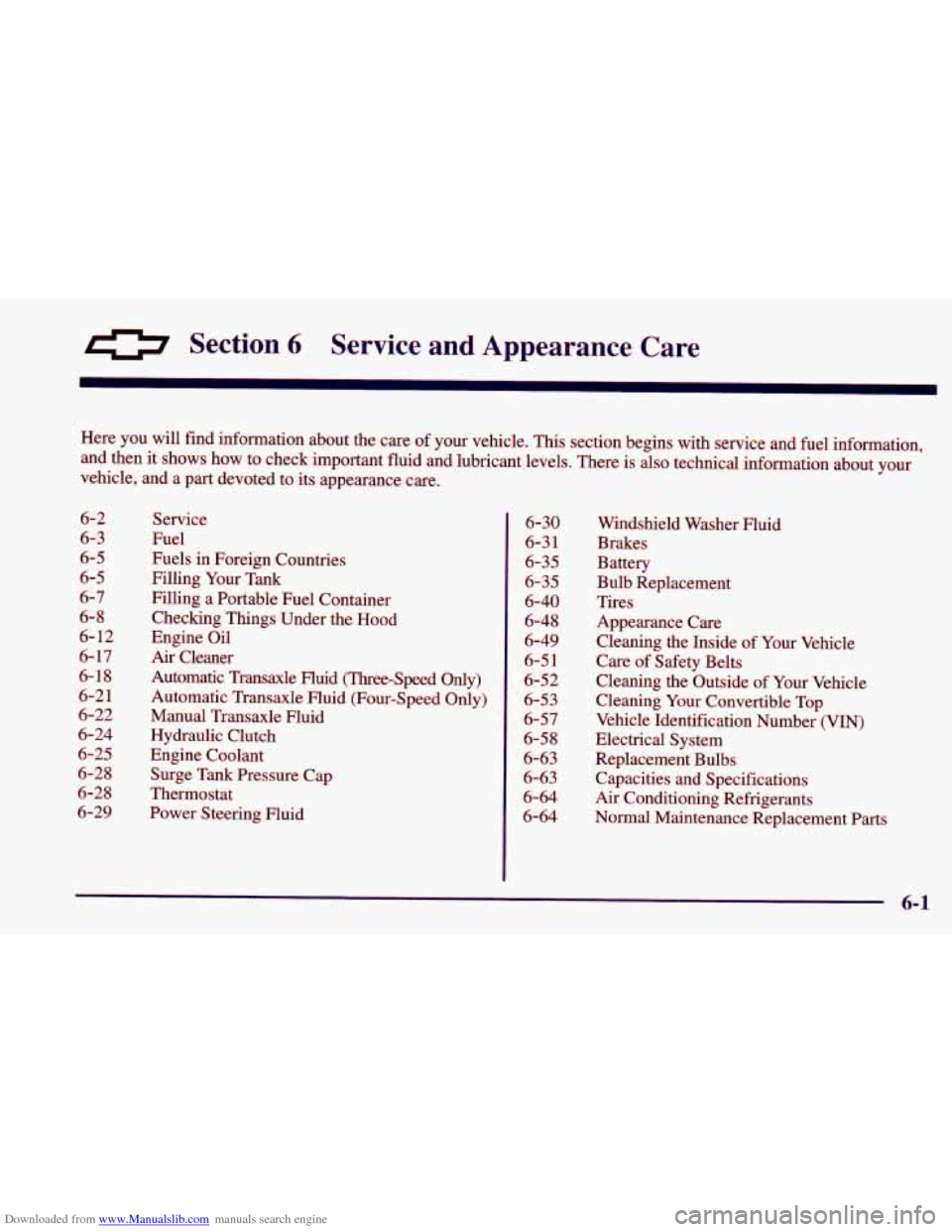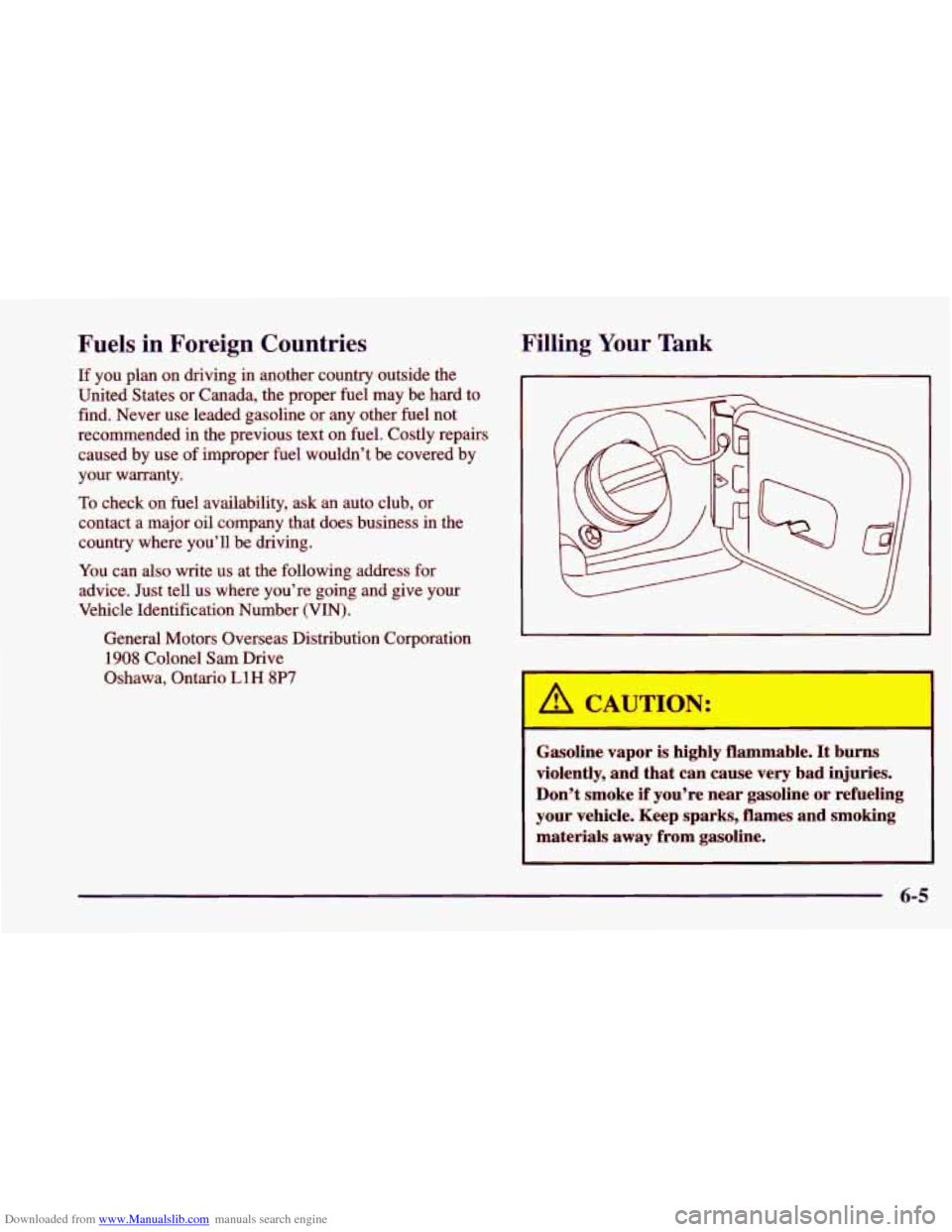Page 251 of 400
Downloaded from www.Manualslib.com manuals search engine 7. Remove any rust or dirt
from the wheel bolts,
mounting surfaces and
spare wheel.
Rust or dirt on the wtd, or on thc ," ;o
which it is fastened, can make the wheel nuts
become loose
after a time. The wheel could come
off and cause an accident. When you change a
wheel, remove any rust or dirt from the places
where the wheel attaches
to the vehicle. In an
emergency,
you can use a cloth or a paper towel
to do this; but be sure to use
a scraper or wire
brush later,
if you need to, to get all the rust or
dirt off.
h CAUTION: I
Never use oil or grease on studs or nuts. If you
do, the nuts might come loose, Your wheel could
fall
off, causing a serious accident,
1 wheel-mounting
surface. Replace the
wheel nuts with the
rounded end
of the nuts
toward the wheel.
Tighten each nut
by
hand or with the wheel
wrench until the wheel
is held against the hub.
8. Place the spare on the
5-29
Page 259 of 400

Downloaded from www.Manualslib.com manuals search engine 0 Section 6 Service and Appearance Care
I
Here you will find information about the care of your vehicle. This section begins with service and fuel informa\
tion,
and then it shows how to check important fluid and lubricant levels. There is also technical information about your
vehicle, and a part devoted to its appearance care.
6-2
6-3
6-5
6-5
6-7
6- 8
6- 12
6- 17
6-18
6-2
1
6-22
6-24
6-25
6-28
6-28
6-29
Service
Fuel
Fuels in Foreign Countries
Filling Your
Tank
Filling a Portable Fuel Container
Checking Things Under the Hood
Engine Oil
Air Cleaner
Automatic Transaxle Fluid (Three-Speed
Only)
Automatic Transaxle Fluid (Four-Speed Only)
Manual Transaxle Fluid
Hydraulic Clutch
Engine Coolant Surge Tank Pressure Cap
Thermostat
Power Steering Fluid
6-30
6-3
1
6-35
6-35
6-40
6-48
6-49
6-5
1
6-52
6-53
6-57
6-58
6-63
6-63
6-64
6-64
Windshield Washer Fluid
Brakes
Battery
Bulb Replacement
Tires
Appearance Care
Cleaning the Inside of
Your Vehicle
Care
of Safety Belts
Cleaning the Outside
of Your Vehicle
Cleaning Your Convertible Top
Vehicle Identification Number
(VIN)
Electrical System
Replacement Bulbs
Capacities and Specifications
Air Conditioning Refrigerants
Normal Maintenance Replacement Parts
6-1
Page 263 of 400

Downloaded from www.Manualslib.com manuals search engine Fuels in Foreign Countries Filli~ : Your Tank
If you plan
on driving in another country outside the
United States or Canada, the proper fuel may be hard to
find. Never use leaded gasoline or any other fuel not
recommended in the previous text on fuel. Costly repairs
caused by use
of improper fuel wouldn’t be covered by
your warranty.
To check on fuel availability, ask an auto club, or
contact a major oil company that does business in the
country where you’ll be driving.
You can also write us at the following address for
advice. Just tell us where you’re going and give your
Vehicle Identification Number
(VIN).
General Motors Overseas Distribution Corporation
1908 Colonel Sam Drive
Oshawa, Ontario
LlH 8P7
Gasoline vapor is highly flammable. It burns
violently, and that can cause
very bad injuries.
Don’t smoke if you’re near
gasoline or refueling
your vehicle. Keep sparks, flames and smoking
materials away from gasoline.
I
6-5
Page 266 of 400
Downloaded from www.Manualslib.com manuals search engine Zhecking Things Under the Hood
A CAUTION:
An electric fan under the hood can start up and
injure you even when the engine is not running.
Keep hands, clothing and tools
away from any
underhood electric fan.
The following sections tell you how to check fluids,
lubricants and important parts underhood.
Hood Release
A CAUTION:
I
Things that burn can get on hot engine parts and
start a fire. These include liquids like gasoline,
oil, coolant, brake fluid, windshield washer and
other fluids, and plastic or rubber. You or others
could be burned.
Be careful not to drop or spill
things that will burn onto
a hot engine.
To open the hood, first pull
the handle inside the vehicle
on the driver’s side under
the instrument panel.
6-8
Page 268 of 400
Downloaded from www.Manualslib.com manuals search engine 2.2L Engine (Code 4)
When you open the hood, you'll see:
A. Coolant Surge Tank
B. Power Steering Fluid Reservoir
C. Engine Oil Fill CapDipstick
D. Brake Fluid Reservoir
E. Hydraulic Clutch Fluid
Reservoir
(If Equipped)
F. Automatic Transaxle Fluid
Dipstick
(If Equipped)
G. Air Cleaner
H. Battery
1. Windshield Washer
Fluid Reservoir
6-10
Page 269 of 400
Downloaded from www.Manualslib.com manuals search engine 2.4L Engine (Code T)
When you open the hood, you'll see:
A. Coolant Surge Tank
B. Engine Oil Fill Cap
C. Engine Oil Dipstick
D. Power Steering Fluid Reservoir
E. Brake Fluid Reservoir
F. Hydraulic Clutch Fluid
Reservoir
(If Equipped)
G. Battery
H. Air Cleaner
I. Windshield Washer
Fluid Reservoir
6-11
Page 270 of 400
Downloaded from www.Manualslib.com manuals search engine Engine Oil
It's a good idea to check your engine oil every time you
get fuel. In order to get
an accurate reading, the oil must
be warm and the vehicle must
be on level ground.
Check the oil here if you
have
a 2.2L engine.
Check the oil here if you have a 2.4L engine. The
dipstick's handle will be a yellow ring.
Turn off the engine and give the oil a few minutes to
drain back into the oil pan. If you don't, the oil dipstick
might not show the actual level.
6-12
Page 271 of 400
Downloaded from www.Manualslib.com manuals search engine Checking Engine Oil
Pull out the dipstick and clean it with a paper towel or
cloth, then push it back in all the way. Remove it again.
keeping the tip down, and check the level.
When to Add Engine Oil
If the oil is at or below the ADD mark, then you’ll need
to add at least one quart of oil. But you must use the
right kind. This part explains what kind
of oil to use. For
crankcase capacity, see “Capacities and Specifications”
in the Index.
I NOTICE:
Don’t add too much oil. If your engine has so
much oil that the oil level gets above the upper
mark that shows the proper operating range,
your engine could be damaged.
This is where you add oil if you have a 2.2L engine.
6-13